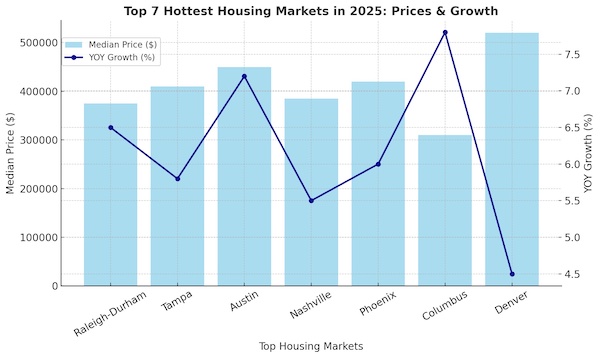2025 is the year first-time buyers finally get a shot. With mortgage rates easing and inventory bouncing back, these seven cities stand out for their mix of affordability, job growth, and lifestyle perks. Each market comes with a “Why Here – Why Now” breakdown plus buyer tips on where to look for the best deals.
Why 2025 Is a Turning Point for Housing
2025 is reshaping the U.S. housing market. After years of sky-high prices and limited inventory, buyers are starting to gain leverage. Mortgage rates are dipping compared to 2024 highs, more listings are coming online, and first-time buyers—especially Millennials and Gen Z—finally have a path to ownership.
But not every city offers the same opportunity. Some remain overpriced, while others quietly combine affordability, economic growth, and quality of life. Below are the 7 hottest housing markets in 2025, with clear answers to Why here? Why now?
The Top 7 Housing Markets in 2025
1. Raleigh-Durham, North Carolina
Known as the “Silicon Valley of the South,” Raleigh-Durham mixes booming tech jobs with affordable housing stock.
Why Here? Tech, healthcare, and education are thriving, attracting young professionals and families.
Why Now? Prices are still below coastal averages, but values are rising quickly as demand grows.
Buyer Tip: Look at suburbs like Cary and Apex for starter homes near the Research Triangle.
2. Tampa, Florida
Florida continues to draw new residents, and Tampa is leading the charge with affordability and lifestyle.
Why Here? Waterfront living, no state income tax, and job growth in logistics and healthcare.
Why Now? Inventory gains in 2025 reduce bidding wars—but competition will heat up as rates ease.
Buyer Tip: Wesley Chapel and Riverview offer affordable suburban options with quick commutes.
3. Austin, Texas
After a slowdown, Austin is bouncing back as one of the strongest rebound markets.
Why Here? Thriving startup culture, live music, and steady migration from higher-cost cities.
Why Now? Prices corrected in 2023–2024, giving buyers a rare window before appreciation accelerates.
Buyer Tip: Check out Pflugerville and North Austin for affordability close to tech campuses.
4. Nashville, Tennessee
Music City is more than honky-tonks—it’s a growing job hub with attainable housing.
Why Here? Job opportunities in healthcare, education, and entertainment.
Why Now? Increasing population will push home values up quickly if you wait too long.
Buyer Tip: Antioch and Donelson are great starter-home neighborhoods with city access.
5. Phoenix, Arizona
One of the fastest-growing metros, Phoenix is regaining balance after pandemic price surges.
Why Here? Expanding job base, affordable cost of living compared to California, and new builds.
Why Now? Prices have cooled, but population growth will fuel another upward swing.
Buyer Tip: Look at Gilbert or Buckeye for affordable new construction options.
6. Columbus, Ohio
Affordable and underrated, Columbus is getting massive corporate investments.
Why Here? Intel and Amazon are injecting billions into the region, creating jobs and demand.
Why Now? Buyers can still enter at lower prices before large-scale corporate expansion drives values up.
Buyer Tip: Grove City and Hilliard are smart starter-home areas within commuting distance.
7. Denver, Colorado
Denver is stabilizing, offering opportunities despite higher price points.
Why Here? Strong economy, outdoor lifestyle, and steady long-term demand.
Why Now? Inventory loosens in 2025, opening doors before the next buyer wave hits.
Buyer Tip: Aurora and Northglenn offer better affordability while staying close to Denver jobs.
Housing at a Glance: Prices & Growth
To put this into perspective, here’s a quick snapshot of how these markets stack up:

The chart above highlights affordability (Columbus, Raleigh-Durham) compared to higher-demand markets (Denver, Austin), helping first-time buyers weigh trade-offs between price and momentum.
Final Thoughts
The U.S. housing market in 2025 is all about timing and location. With mortgage rates easing and inventory improving, buyers who act now can lock in equity growth before competition spikes again.
Your best move? Get pre-approved, set a budget, and explore these seven cities—because the window for affordable entry won’t stay open forever.
For personalized mortgage options in any of these markets, check out the Mortgage Research Network (link is not live for now) for tailored guidance.
FAQs
Q: Should I wait until rates drop further before buying?
A: Waiting could mean higher competition and prices. Acting now lets you catch the balance of easing rates and increasing inventory.
Q: Which of these markets are best for investment properties too?
A: Columbus and Raleigh-Durham show the strongest ROI potential, while Tampa and Nashville balance growth with rental demand.
Q: How much do I need for a down payment?
A: First-time buyer programs may allow as little as 3–5% down, though 10–20% is ideal to reduce monthly payments.
Resources
National Association of Realtors Housing Forecast
HUD First-Time Homebuyer Programs
See more in Housing Insights.
Disclaimer
This content is for informational purposes only and does not constitute financial or legal advice. Always consult a licensed professional before making home-buying decisions.




